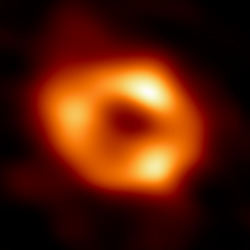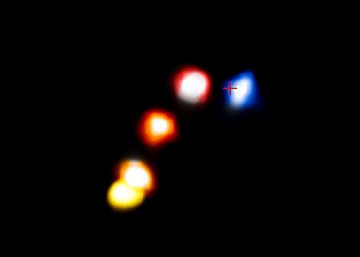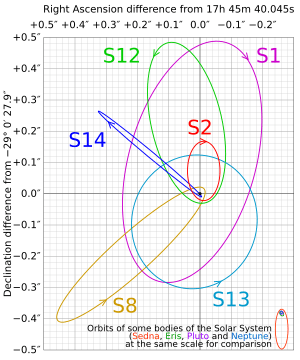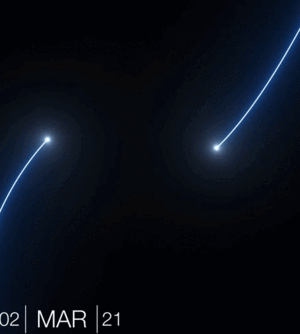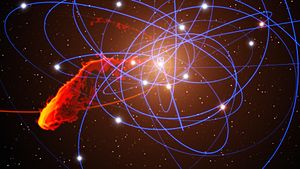Sagittarius A* facts for kids
| Observation data Epoch J2000 Equinox J2000 |
|
|---|---|
| Constellation | Sagittarius |
| Right ascension | 17h 45m 40.0409s |
| Declination | −29° 0′ 28.118″ |
| Details | |
| Mass | 8.54×1036 kg 4.297×106 M☉ |
| Astrometry | |
| Distance | 26996±29 ly (8277±9 pc) |
| Database references | |
| SIMBAD | data |
Sagittarius A* (pronounced AY-star), often shortened to Sgr A* (pronounced SAJ-AY-star), is a supermassive black hole located right at the center of our own galaxy, the Milky Way. From Earth, you can find it in the direction of the Sagittarius and Scorpius constellations. It's visually close to the Butterfly Cluster (M6).
This amazing object is a very bright and compact source of radio waves. The name Sagittarius A* helps us tell it apart from the larger area called Sagittarius A, where it is found. Sgr A* was first discovered in 1974 by Bruce Balick and Robert L. Brown. Brown added the asterisk (*) in 1982 because the strong radio signals seemed to come from a very small, exciting object.
Scientists have studied how several stars orbit around Sagittarius A*, especially a star called S2. By watching these stars, they could figure out how heavy Sgr A* is and how big it can be. Based on these measurements, astronomers are sure that Sagittarius A* is the supermassive black hole at the heart of the Milky Way. It weighs about 4.3 million times the mass of our Sun.
In 2020, scientists Reinhard Genzel and Andrea Ghez won the Nobel Prize in Physics. They were honored for proving that Sagittarius A* is a supermassive, compact object. At the time, a black hole was the only possible explanation for what they observed.
Then, in May 2022, astronomers shared the first-ever image of the area around Sagittarius A*. This image was taken by the Event Horizon Telescope, a huge network of radio observatories around the world. The picture confirmed that Sgr A* is indeed a black hole. This was only the second time a black hole had been directly imaged, after Messier 87's black hole in 2019. We don't see the black hole itself, but rather the glowing gas and dust that are being pulled into it. This gas and dust get super hot, millions of degrees, as they fall in.
Contents
Seeing Sagittarius A*: The First Image
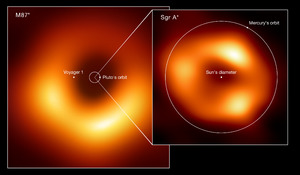
On May 12, 2022, the Event Horizon Telescope Collaboration released the first image of Sagittarius A*. This image was made using radio data collected in 2017. It took five years of complex calculations to create the final picture. The data came from eight radio observatories located in six different places around the world.
The image confirms that Sagittarius A* contains a black hole. This was a huge step in understanding our galaxy's center. The image shows that the black hole has an apparent size of about 51.8 microarcseconds. To give you an idea, if you were standing on Earth, that's like trying to see a donut on the Moon!
At its distance of about 26,000 light-years, this means Sagittarius A* has a diameter of about 60 million kilometers (37 million miles). For comparison, our Earth is 150 million kilometers (93 million miles) from the Sun. The planet Mercury is about 46 million kilometers (29 million miles) from the Sun at its closest point. So, the black hole is smaller than Mercury's orbit around the Sun.
The measurements of these black holes have helped scientists test Einstein's theory of relativity very carefully. So far, the results match his predictions perfectly.
Scientists have not been able to see Sagittarius A* using regular light (the optical spectrum). This is because there is a lot of dust and gas between us and the black hole. This dust blocks the light, making it impossible to see with optical telescopes.
How We Discovered Sagittarius A*
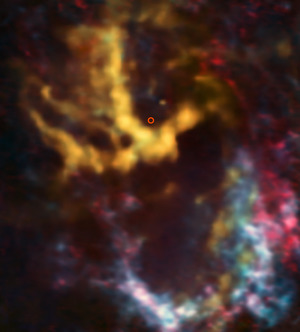
The story of Sagittarius A* began in April 1933. A scientist named Karl Guthe Jansky discovered that a radio signal was coming from the direction of the Sagittarius constellation. This area later became known as Sagittarius A. Jansky is considered one of the founders of radio astronomy.
Later, in 1974, Bruce Balick and Robert L. Brown used a special telescope to find a very bright and compact part within Sagittarius A. They named this part Sgr A*. Brown chose the asterisk (*) because the radio source was "exciting," and excited states in science are often marked with an asterisk.
Since the 1980s, scientists have suspected that the center of Sgr A* was a black hole. In 1994, studies showed that the mass of Sgr A* was very concentrated. It was about 3 million times the mass of our Sun.
A big breakthrough happened on October 16, 2002. A team led by Reinhard Genzel watched the star S2 orbit around Sagittarius A* for ten years. Their observations showed that Sgr A* could not be just a cluster of dark stars or other matter. This strongly supported the idea that it was a massive black hole.
By studying S2's orbit, they calculated that Sagittarius A* has a mass of about 4.1 million solar masses. This huge mass is packed into a space no bigger than 17 light-hours across. (One light-hour is how far light travels in an hour.) For comparison, the entire orbit of Pluto around the Sun is about 11 light-hours across.
In 2008, after watching stars orbit Sgr A* for 16 years, another team led by Reinhard Genzel refined the mass estimate to about 4.31 million solar masses. Genzel stated that this study provided the best proof yet that supermassive black holes truly exist.
On January 5, 2015, NASA reported seeing an X-ray flare from Sgr A* that was 400 times brighter than usual. This was a record-breaking event! Scientists think it might have been caused by an asteroid breaking apart as it fell into the black hole. Or, it could have been caused by magnetic fields getting tangled in the gas flowing into Sgr A*.
In May 2019, astronomers saw Sgr A* suddenly become 75 times brighter than normal. This suggests that the supermassive black hole might have interacted with another object.
What Makes it a Black Hole?
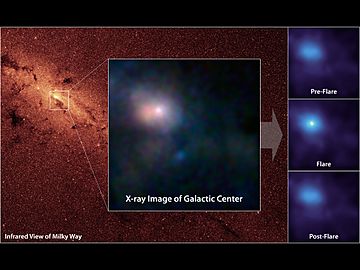
In 2018, scientists announced strong evidence that Sagittarius A* is a black hole. They used a special tool called the GRAVITY interferometer with the Very Large Telescope (VLT). This allowed them to create a "virtual telescope" 130 meters (426 feet) wide. With this, they saw clumps of gas moving at about 30% of the speed of light very close to the black hole.
These bright flares of gas matched what scientists expected to see if hot spots were orbiting a black hole of four million solar masses. These flares are likely caused by magnetic interactions in the super hot gas orbiting very close to Sagittarius A*.
In July 2018, it was reported that the star S2 was recorded moving at 7,650 kilometers per second (about 2.55% the speed of light) as it got closest to Sgr A*. At this close distance, Einstein's general relativity theory predicts that S2 would show a special kind of "gravitational redshift" in its light. This redshift was detected, matching Einstein's prediction.
The radio signals we see from Sagittarius A* don't come from the black hole itself. Instead, they come from a bright spot in the region around the black hole, very close to its event horizon. This could be from the accretion disk (a disk of gas and dust spiraling into the black hole) or a powerful jet of material shooting out from the disk.
Scientists have estimated the mass of Sagittarius A* in two main ways:
- Two groups of scientists watched the orbits of individual stars very close to the black hole. They used Kepler's laws of planetary motion to figure out how much mass must be pulling on those stars. The German group found a mass of 4.31 million solar masses, and the American group found 4.1 million solar masses. This mass is packed into a sphere about 44 million kilometers (27 million miles) wide.
- More recently, scientists measured the movements of thousands of stars near the black hole. They used a statistical method to estimate the black hole's mass at about 3.6 million solar masses. They also found about 1 million solar masses of other stars and leftover stellar objects in the central area.
What we observe is not the black hole itself, but rather effects that can only be explained by the presence of a black hole near Sgr A*. The radio and infrared energy we detect comes from gas and dust that are heated to millions of degrees as they fall into the black hole. The black hole itself is thought to emit only a tiny amount of radiation, called Hawking radiation, at an incredibly cold temperature.
In July 2019, astronomers found a star called S5-HVS1 traveling at an incredible speed of 1,755 kilometers per second (about 0.006 times the speed of light). This star is about 29,000 light-years from Earth. Scientists believe it might have been shot out of the Milky Way galaxy after interacting with Sagittarius A*.
Stars Orbiting Sagittarius A*
There are many stars that orbit very closely around Sagittarius A*. These are known as "S stars." We mostly see these stars using infrared light because interstellar dust blocks visible light. This is an exciting area of study, and new discoveries are made often. For example, the star S62 has been found to get even closer to the black hole than other known stars.
Because these stars move so fast and get so close to the supermassive black hole, they are very useful. They help scientists figure out the exact size of Sagittarius A*. They also allow scientists to observe effects predicted by general relativity, like how the closest point in a star's orbit shifts over time. Scientists are always watching to see if any stars might get close enough to be torn apart by the black hole, but so far, none of these stars are expected to suffer that fate.
As of 2020, the star S4714 holds the record for the closest approach to Sagittarius A*. It gets as close as about 12.6 AU (an AU is the distance from Earth to the Sun). This is almost as close as Saturn gets to the Sun! S4714 travels at about 8% of the speed of light during this close approach. Its orbit takes 12 years, but it's a very stretched-out orbit, which allows it to get so close and move so fast.
Here is a table showing some of the most important stars orbiting Sagittarius A*:
| id1 | id2 | a | e | i (°) | Ω (°) | ω (°) | Tp (yr) | P (yr) | Kmag | q (AU) | v (%c) |
|---|---|---|---|---|---|---|---|---|---|---|---|
| S1 | S0-1 | 0.5950 | 0.5560 | 119.14 | 342.04 | 122.30 | 2001.800 | 166.0 | 14.70 | 2160.7 | 0.55 |
| S2 | S0-2 | 0.1251 | 0.8843 | 133.91 | 228.07 | 66.25 | 2018.379 | 16.1 | 13.95 | 118.4 | 2.56 |
| S8 | S0-4 | 0.4047 | 0.8031 | 74.37 | 315.43 | 346.70 | 1983.640 | 92.9 | 14.50 | 651.7 | 1.07 |
| S12 | S0-19 | 0.2987 | 0.8883 | 33.56 | 230.10 | 317.90 | 1995.590 | 58.9 | 15.50 | 272.9 | 1.69 |
| S13 | S0-20 | 0.2641 | 0.4250 | 24.70 | 74.50 | 245.20 | 2004.860 | 49.0 | 15.80 | 1242.0 | 0.69 |
| S14 | S0-16 | 0.2863 | 0.9761 | 100.59 | 226.38 | 334.59 | 2000.120 | 55.3 | 15.70 | 56.0 | 3.83 |
| S62 | 0.0905 | 0.9760 | 72.76 | 122.61 | 42.62 | 2003.330 | 9.9 | 16.10 | 16.4 | 7.03 | |
| S4714 | 0.102 | 0.985 | 127.7 | 129.28 | 357.25 | 2017.29 | 12.0 | 17.7 | 12.6 | 8.0 |
The Mystery of Gas Cloud G2
In 2002, scientists noticed something unusual in images of the Milky Way's center: a gas cloud named G2. This cloud, about three times the mass of Earth, seemed to be on a path that would take it very close to Sagittarius A*. In 2012, a paper confirmed this. Scientists predicted that G2 would make its closest approach to the black hole in early 2014. At that point, it would be about 3,000 times the size of the black hole's event horizon away.
Since 2009, G2 had been observed breaking apart. Some scientists thought it would be completely destroyed by the black hole's strong gravity. They hoped this event would cause a big burst of X-rays and other light from the black hole, giving them a chance to learn more about how material falls into supermassive black holes.
However, other astronomers thought G2 might be hiding a dim star or two stars merged together. If so, this hidden star would help the cloud stay together against the black hole's pull. Many telescopes around the world, like Chandra and VLA, watched G2's closest approach.
When G2 finally passed by the black hole, there were no big "fireworks" or bright flashes as some had expected. It was described as a "flop" by some. Observations in March 2014 showed that G2 was still mostly together. This suggested that the cloud likely had a central star, which helped it resist the black hole's powerful gravity.
Later analysis in July 2014 suggested that G2 might not be a single, isolated cloud. Instead, it could be a dense clump within a continuous, thinner stream of gas. This stream would act like a constant gentle breeze on the disk of matter orbiting the black hole, rather than sudden strong gusts. This idea was supported by the fact that another cloud, G1, which passed the black hole 13 years earlier, had a very similar orbit to G2.
Professor Andrea M. Ghez and her team suggested in 2014 that G2 was not a gas cloud at all. They thought it might be two binary stars that had been orbiting the black hole together and then merged into one very large star.
Related Pages
- Sagittarius A
- Sagittarius
- List of nearest known black holes
See also
 In Spanish: Sagitario A* para niños
In Spanish: Sagitario A* para niños


